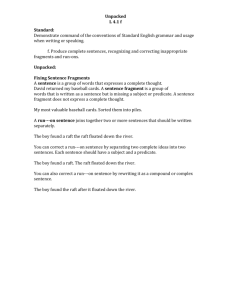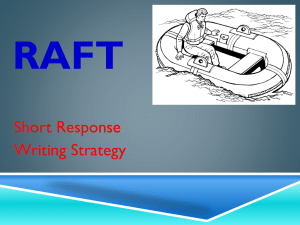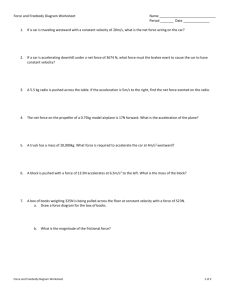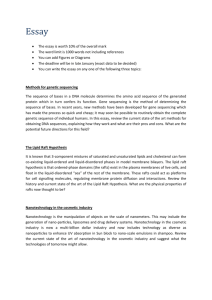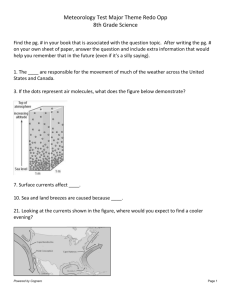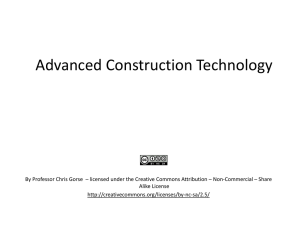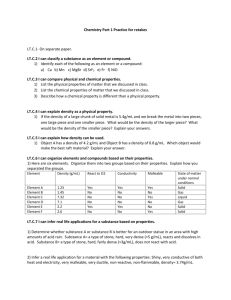World Cultures - CCSSO projects - Council of Chief State School
advertisement
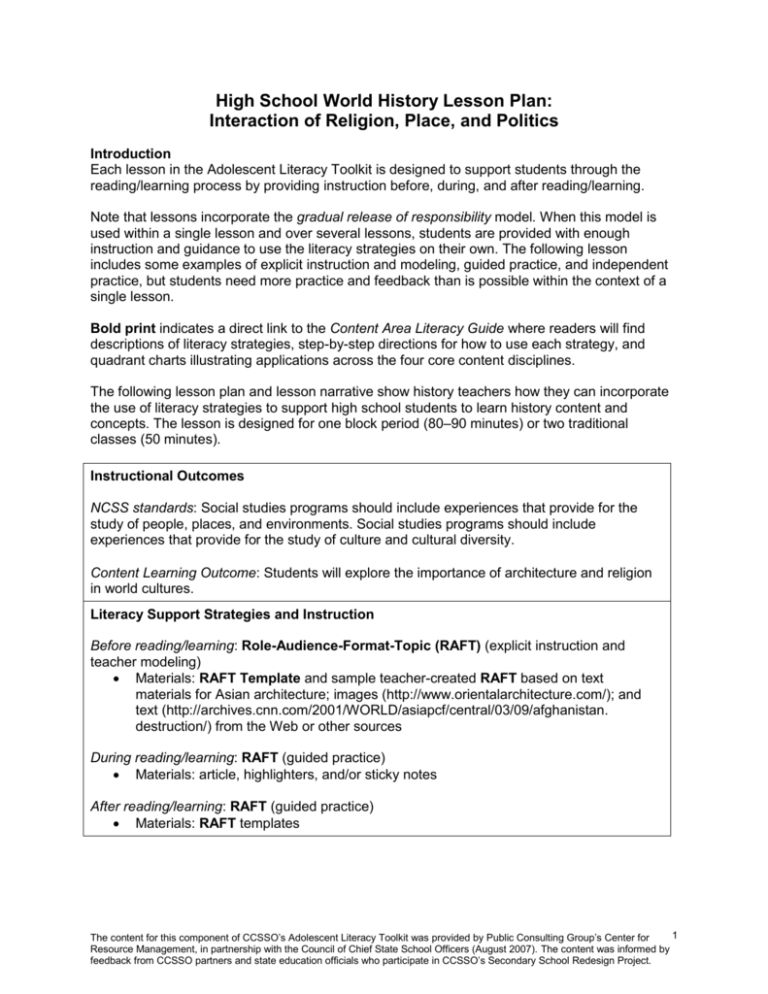
High School World History Lesson Plan: Interaction of Religion, Place, and Politics Introduction Each lesson in the Adolescent Literacy Toolkit is designed to support students through the reading/learning process by providing instruction before, during, and after reading/learning. Note that lessons incorporate the gradual release of responsibility model. When this model is used within a single lesson and over several lessons, students are provided with enough instruction and guidance to use the literacy strategies on their own. The following lesson includes some examples of explicit instruction and modeling, guided practice, and independent practice, but students need more practice and feedback than is possible within the context of a single lesson. Bold print indicates a direct link to the Content Area Literacy Guide where readers will find descriptions of literacy strategies, step-by-step directions for how to use each strategy, and quadrant charts illustrating applications across the four core content disciplines. The following lesson plan and lesson narrative show history teachers how they can incorporate the use of literacy strategies to support high school students to learn history content and concepts. The lesson is designed for one block period (80–90 minutes) or two traditional classes (50 minutes). Instructional Outcomes NCSS standards: Social studies programs should include experiences that provide for the study of people, places, and environments. Social studies programs should include experiences that provide for the study of culture and cultural diversity. Content Learning Outcome: Students will explore the importance of architecture and religion in world cultures. Literacy Support Strategies and Instruction Before reading/learning: Role-Audience-Format-Topic (RAFT) (explicit instruction and teacher modeling) Materials: RAFT Template and sample teacher-created RAFT based on text materials for Asian architecture; images (http://www.orientalarchitecture.com/); and text (http://archives.cnn.com/2001/WORLD/asiapcf/central/03/09/afghanistan. destruction/) from the Web or other sources During reading/learning: RAFT (guided practice) Materials: article, highlighters, and/or sticky notes After reading/learning: RAFT (guided practice) Materials: RAFT templates 1 The content for this component of CCSSO’s Adolescent Literacy Toolkit was provided by Public Consulting Group’s Center for Resource Management, in partnership with the Council of Chief State School Officers (August 2007). The content was informed by feedback from CCSSO partners and state education officials who participate in CCSSO’s Secondary School Redesign Project. Before Reading/Learning (20 minutes) Literacy outcome: Students will use RAFT to set a purpose for reading and stimulate interest in the reading and learning using multiple points of view. Teacher preparation: 1) Prepare a handout that scaffolds students’ understanding of topics, people, unfamiliar vocabulary, or specific text references students may not already know. 2) Create a RAFT Template with sample Roles, Audiences, Formats, and Topics related to the text students will be asked to read. Example of a RAFT Template: Role Newspaper reporter Silk Road merchant Audience Readers in Asia UNESCO team Format Obituary Speech Interior Minister Moinuddin Haider Taliban chief Mullah Mohammad Omar Japanese preservationists Self Diary Topic Destruction of Buddha statues The value of the statues to UNESCO member countries Changes to homeland Local children Instructions Dangers of idolatry Taliban Foreign Minister Mulla Wakil Ahmed Muttawakil London newspaper Letter Sri Lankan Prime Minister Ratnasiri Wickeremanayaka Proposal Ahmed Muttawakil American journalists Letter Statues Self Diary Plan for removal and transportation of statues to Japan Possible alternatives to destruction of statues Need for world voices to stop the Taliban disregard for ancient practices and joint action Bias in reporting on destruction of Buddha statues Witnessing cultural conflict A London-based Afghan engineer Members of the Japanese parliament Editorial Teacher facilitation: 1) Begin by connecting the topic of architectural icons to the study of Asian cultures. Remind students this is not a separate lens through which to learn about and understand cultures, but another layer by which to explore the interactions of people, places, and cultures. Tell students you are going to begin with an event that made the news in 2001 about the destruction of the Bamiyan Buddha statues in Afghanistan by Taliban forces. The purpose for reading this article is to understand how certain cultures relate to architectural icons and how those icons affect world cultures. Distribute and review the handout to scaffold students’ understanding of topics, people, unfamiliar vocabulary, or specific text references. 2) Tell students that, after reading, they will be doing a piece of writing about this event using the RAFT strategy. Explain that in order to help them explore the interactions of people, places, and cultures through the study of this event, they are going to use a literacy strategy, called a RAFT, which lets the writer choose a Role, Audience, Format, and Topic to summarize their learning or advocate a particular point of view about it. This strategy will help students get beyond just retelling or summarizing what 2 The content for this component of CCSSO’s Adolescent Literacy Toolkit was provided by Public Consulting Group’s Center for Resource Management, in partnership with the Council of Chief State School Officers (August 2007). The content was informed by feedback from CCSSO partners and state education officials who participate in CCSSO’s Secondary School Redesign Project. they read. Students will use the strategy to synthesize what they have read using different points of view. Tell students you have provided a variety of RAFTs they can choose before they read. This will help them read the article with a specific purpose in mind: to find information that helps them understand the Role, Audience, and Topic they have selected for their RAFT. 3) To build background knowledge and understanding, tell students you are going to show them how to do the RAFT strategy before reading, so that during reading they can be looking for places in the text that will help them understand the roles/audiences they have chosen for their own RAFTs, and the topics related to the text. Pass out copies of the text that describes the Bamiyan Buddha statues and their destruction. Read the title of the article with students and take a moment to allow them to survey the article, prompting them to look at pictures, read captions and headers, and identify the source, date, and location of the news report. Pass out copies of the RAFT Template and let them read it briefly. Discuss the sample RAFTs on the template. 4) Next, show students how you did your own RAFT using a Think-Aloud to model how you read the article and wrote your own RAFT. Show students the Role, Audience, Format, and Topic you selected for your RAFT before you start reading. Role Smaller Bamiyan Buddha statue Audience 9th grade history class Format Persuasive memo Topic Need for world intervention against complete destruction Ask students to tell you what types of language might be used in a persuasive memo. Read the first section of the article aloud, stopping when you come to a place that provides information to help you understand how the statues might have interpreted the information. For example, the headline in the article is ‘Pakistan and Japan plead for Afghan statues.’ Explain your thinking: “I am going to highlight Pakistan and Japan, since I think they share a point of view. They are pleading to save the statues. I might be able to use their arguments in my memo.” Continue through the first section of the article, noting points of view and verbs that could be used to write a persuasive memo, like plead. Underline, highlight, or place a sticky note next to text that represents the statues’ point of view. 5) Then Think-Aloud while you write your own RAFT on an LCD or overhead (see following sample). Show students how you set up the page as a persuasive memo (see sample below). Write or share the first part of your RAFT. Explicitly connect your thinking and rationale for including certain information to information you highlighted in the first section of the article. Stress the fact that the purpose of the RAFT is to support critical thinking. Remind them that writing can be used as a vehicle for learning and is not always a form of assessment. Today the RAFT is being used as a vehicle for learning about the multiple and conflicting points of view represented in this article about the Bamiyan Buddha statues. 3 The content for this component of CCSSO’s Adolescent Literacy Toolkit was provided by Public Consulting Group’s Center for Resource Management, in partnership with the Council of Chief State School Officers (August 2007). The content was informed by feedback from CCSSO partners and state education officials who participate in CCSSO’s Secondary School Redesign Project. Review with the students what they already know about the Formats that are represented on the RAFT template. Briefly review the text features of those Formats. If possible, have sample forms of each type of writing posted on the classroom wall or available for reference. Sample of the RAFT modeled by the teacher: To: From: RE: Date: Mr. White’s 9th grade World Cultures Class Smaller Bamiyan Buddha Statue Reason for reporting on Destruction March 1, 2001 We have been here for nearly 15 centuries, give or take one. We have witnessed the development of the Silk Road, the rise and fall of several ancient cultures, and the more recent conflict in Afghanistan, Pakistan, and Southeast Asia. We have stood as symbols of Buddhism and the influence of our religion all over Asia, even when Islam displaced Buddhism in Afghanistan in the 9th century. Now tolerance for religious difference and respect for ancient cultures, history, and religion has disappeared and led to our destruction. We have lost our heads and our feet. If we are completely destroyed, this will be more than just the obliteration of a statue. This will be the obliteration of peace, tolerance for difference, and respect for our common history. If the world doesn’t pay attention to this, more destruction will come of it. 6) Tell students to work with a partner to select a RAFT from the template. Have students Turn and Talk with another pair to get ideas. Let them know it is okay to use the same RAFT as others in the class, as different pairs will approach the same RAFT in different ways. This is part of how students can learn from each other. During Reading/Learning (25 minutes) Literacy outcome: Students will read the text to find evidence to support the RAFT they intend to write. Teacher facilitation: 1) Pass out highlighters and/or sticky notes. 2) Ask students to read the assigned text, independently or in pairs, focusing on identifying the points of view associated with the Role, Audience, and Topic they selected from the list of RAFT samples. Remind students they will be marking them with a highlighter or sticky note in the same manner that was modeled for them. 3) Circulate as students work, quietly observing their text notations, and stopping to help when necessary. Ask probing questions to help them identify possible conflicting points of view in the text. Students who finish early can quietly discuss responses, connections, or questions about the text with a partner. After Reading/Learning (35 minutes) Literacy outcome: Students will communicate their thinking and synthesize information by writing a RAFT individually or in pairs. 4 The content for this component of CCSSO’s Adolescent Literacy Toolkit was provided by Public Consulting Group’s Center for Resource Management, in partnership with the Council of Chief State School Officers (August 2007). The content was informed by feedback from CCSSO partners and state education officials who participate in CCSSO’s Secondary School Redesign Project. Teacher facilitation: 1) Project the RAFT template on the board. Ask students to raise their hands if they found places in the text that might help them understand the particular point of view represented by the RAFT they have chosen on the template in the Role category. Have several students read aloud from the text where they highlighted a possible point of view. Then discuss some of the Topics on the template. 2) Elicit some responses from students about their plans for their RAFTs. Use this class discussion to clarify any confusion about how to write a RAFT. Then ask students to get into their pairs to get ready to write. Tell students to do a two-minute oral rehearsal. One person will talk for two minutes, thinking out loud about how he or she might go about writing the RAFT, and the other person takes notes. Then switch roles and have the note taker be the talker/planner and the talker/planner be the note taker. 3) Once both partners have rehearsed orally, tell students they will now write their RAFTs. They will be sharing in small groups after everyone finishes a RAFT. Emphasize the fact that this is the first time they are doing the strategy and the focus of this assignment is to experiment with points of view found in this article, not to create a perfect piece of writing. 4) Put them into groups of six and explain how they will share their RAFTs. Each pair will explain their Role, Audience, Format, and Topic, and then read their RAFT to the others, explaining how the text supported their thinking and writing. Each pair will share without stopping to take questions or hear responses. The group will pick one RAFT to share with the whole group and explain why it was chosen. Tell them they will share these as a whole group in the next class. 5) In the last five minutes of class, ask students to complete an Exit Slip with the following prompts: One question I have about the destruction of the Bamiyan Buddhas is: One thing that I learned from the article on the destruction of the Bamiyan Buddha statues is: The RAFT strategy was useful/not useful in my learning today because: 6) Collect students’ RAFT writing and Exit Slips. Like all student-completed literacy strategy templates, the completed RAFT writing and Exit Slips provide valuable data for teacher reflection. This writing should not be graded. The student responses should be used to assess student learning and make decisions about next steps in teaching. Suggested Subsequent Lessons Begin the next class by passing back the RAFTs and sharing the selected RAFTs with the whole group. Tell students they will eventually be doing RAFTs independently as an afterreading response to articles and other texts. Then you will encourage them to generate their own Roles, Audiences, Formats, and Topics to help them identify some of the different points of view. 5 The content for this component of CCSSO’s Adolescent Literacy Toolkit was provided by Public Consulting Group’s Center for Resource Management, in partnership with the Council of Chief State School Officers (August 2007). The content was informed by feedback from CCSSO partners and state education officials who participate in CCSSO’s Secondary School Redesign Project. High School World History Lesson Narrative: Interaction of Religion, Place, and Politics Teachers: As you read the lesson narrative, think about the following questions. You may want to discuss them with fellow history teachers. What does the teacher do to support students’ literacy development and content learning before, during, and after reading/learning? What challenges do you anticipate if you were to implement this lesson in your own classroom? How would you prepare to meet these challenges? How would you make improvements to this lesson? Mr. Carter wanted to help his students learn about world cultures through a study of religion, customs, geography, and architecture. Students had begun the unit looking at a map of Asia and identifying different regions and countries. They had been discussing and reading from their textbooks about the geography and religion of the region, which was leading into an exploration of architecture. In the past, students memorized a set of famous buildings, structures, and other icons without really connecting or exploring the relationship between geography, architecture, and culture. Mr. Carter wanted to find a way to help them consider the interactions between geography, culture, and architecture. He chose an Asian country that had experienced multiple cultural transitions, and a literacy strategy that would help students explore those transitions, called Role/Audience/Format/Topic (RAFT). RAFT is a strategy that helps students write from a variety of perspectives by taking on various roles, write for a variety of audiences, and select from a variety of writing formats and content topics. Mr. Carter decided to try it, knowing that writing to learn is a powerful way to promote critical thinking. Before Reading/Learning “We’re going to continue our study of Asia by looking at some notable architectural icons in the region. Many of you were surprised to learn Afghanistan is considered part of Asia and, because it has been in the news lately, I chose the famous Bamiyan Buddhas statues to start with.” He projected an image of the Buddhas for his students to see. “We’ve talked a little bit about the geography and religions of the region. Remember that Islam, Buddhism, and Christianity have all influenced the culture of Asia in one way or another. I want you to understand that we aren’t moving on to architecture and leaving geography and religion behind. What I want you to think about is how these categories overlap and interact to influence the cultures of the region.” “Okay,” said Mr. Carter, leaving the image of the Buddhas projected on the wall. “These are some important statues from Afghanistan called the Bamiyan Buddhas, highlighted in the news in 2001. The Buddhas are ancient relics from a time when this part of the country was not ruled by Islam. They are located in the desert along the Silk Road, which was an important route for the rug and textile trade. We’ll talk about that more when we begin exploring the natural resources and economy in Asia. Can you guess how old these statues are?” He waited and Joe, an avid reader and video game player, raised his hand. “In one of my video games we use ancient empires. I know I’ve heard of the Silk Road from that. So I’m going to guess they are at least eight centuries old.” Mr. Carter gave him a “thumbs up” and told students the statues are thought to be about 15 centuries old, but there is no definitive authority on their exact age. “It’s really hard to wrap your mind around how many people have walked by these statues in the 15 or so centuries they’ve been in existence. Think about that as you read. Before we start 6 The content for this component of CCSSO’s Adolescent Literacy Toolkit was provided by Public Consulting Group’s Center for Resource Management, in partnership with the Council of Chief State School Officers (August 2007). The content was informed by feedback from CCSSO partners and state education officials who participate in CCSSO’s Secondary School Redesign Project. reading, I want to teach you about a strategy you are going to use to respond to the article which will help you explore the overlap between architecture, religion, and the geography of Asia. This strategy is called RAFT which stands for Role, Audience, Format, and Topic. Instead of writing a retelling or a summary of the article, you will be doing a kind of writing that helps you explore points of view. Sometimes those points of view are in conflict, sometimes they are not.” Mr. Carter distributed the handout he had prepared to scaffold students’ understanding of topics, people, unfamiliar vocabulary, or specific text references. “Let’s begin by thinking about what you know about Afghanistan.” Several students immediately raised hands. One yelled out, “That’s where Al Qaeda is hiding out.” Mr. Carter called on one of the quieter girls who added, “The Kite Runner was on our 9th grade summer reading list. It takes place in Afghanistan and I learned a little about how the Taliban came in and took over.” Mr. Carter nodded. “So, there was a different government before the Taliban. And there is Al Qaeda. The Taliban and Al Qaeda are not the same thing. And all three groups represent somewhat different, if not conflicting, points of view. So, if you think about an event in Afghanistan, there are at least three different points of view to consider, right?” Students nodded. “All right, now I want to show you another image.” Mr. Carter projected an image of the statues after they were destroyed by the Taliban. “What happens when these architectural structures are destroyed? Why were they destroyed? Who will be affected by this? Why does it matter? When you read this article, you will be reading it to find the answers to these questions. Notice that I am suggesting there may not be a single answer to these questions. That is where the RAFT comes in. Let me explain.” Mr. Carter told students that, after reading, they would be doing a piece of writing about this event using the RAFT strategy. “This is a strategy to help you react to and synthesize your thinking about your reading from a different point of view than your own and to a different audience than the teacher.” Mr. Carter projected the RAFT Template and let students read over it briefly. He then explained each of them would be choosing from the RAFTs listed on the template for their own RAFT. “Work with a partner to select a Role you might want to write from. Turn and Talk with another pair to get ideas. It is okay to use the same RAFT as others in the class, as different pairs will approach the same information in different ways. This is part of how we learn from each other,” he reminded them. “The Role is who you will be when you write. You are not going to be writing as yourself. And you have a very particular audience. Who are you writing to? We often talk about the importance of knowing who your audience is when you write. This strategy helps you think about the different players in an event by allowing you to choose one of them as your audience for this piece of writing.” He explained format, giving them time to look at the list of formats on the template. “This is the form your writing will take. The features of your writing will be determined by the format you choose. In a minute, I’m going to show you how I wrote a RAFT using a memo format. Let’s do a quick review of the features of some of these other formats. How about an obituary? What features does it have?” Students offered suggestions helping Mr. Carter record the text features of some of these formats on the board, so students who might need some help could see how to do it. He reminded students that he had posted samples of various formats on the wall and they could get up to look at those if they needed ideas about how to create a certain one. Several students showed interest when formats like obituary, petition, rap lyrics, and news release were listed. Then he explained the different topics he’d 7 The content for this component of CCSSO’s Adolescent Literacy Toolkit was provided by Public Consulting Group’s Center for Resource Management, in partnership with the Council of Chief State School Officers (August 2007). The content was informed by feedback from CCSSO partners and state education officials who participate in CCSSO’s Secondary School Redesign Project. used as examples. “My topics are not random. They all relate to each other and to our reading in some way.” “I’m going to show you how reading with a purpose, like RAFT provides, helps you identify important information about the different points of view represented in text. In this article,” he began passing out the article, “you’ll be reading to gather information about the role, audience, and topic you selected. Then you’ll use the format to help you synthesize, in writing, what you learned. You each have a copy of the article and the RAFT Template. First, let’s survey the article together.” Mr. Carter called on Sam to read the title. Then he asked students to look over the pictures and the captions. Another volunteer read the headers aloud. “Now, after surveying the article, look over the RAFT Template again and consider some of the choices listed there.” He paused for a moment, then went on, “Now I want you to Turn and Talk to predict why I chose the examples I have here in each category. What might they have to do with this article on the Bamiyan Buddha statues? For example, why might I have included the Sri Lankan Prime Minister?” He gave students a chance to talk in pairs. Though they were slow to engage, he knew they would probably enjoy this type of writing once they understood it, so he pressed on. “Once you decide what your Role, Audience, and Topic are going to be, you can read the text keeping those in mind. Here’s the RAFT I came up with for my piece of writing.” Mr. Carter wrote his own Role—statues, Audience—students in a 9th grade class, Format—persuasive memo, and Topic—need for world intervention against complete destruction. Mr. Carter projected a copy of the article. “When I read the first section of the article, I’ll be keeping these in mind. When I come to a place in the text that helps me understand something about my RAFT, I’m going to highlight it. Watch me now, and listen while I show you how to do this.” Mr. Carter read through the first section of the article, stopping to think aloud and highlight information that represented a point of view, and identifying the specific places he would be using to write his RAFT. “As you read, I want you to stop when you come to a place that suggests a particular point of view. Underline, highlight, or place a sticky note next to the text that carries a point of view.” “For example, the headline in the article is ‘Pakistan and Japan plead for Afghan statues.’ I am going to highlight Pakistan and Japan, since I think they share a point of view. They are pleading to save the statues. Now I need to see who they might be making a plea to, their audience, since that would represent another point of view.” Mr. Carter continued reading through the first section of the article, noting points of view and possible formats that might be appropriate for some of the samples on the RAFT Template. He stressed the purpose of the RAFT is to support critical thinking. “I want to remind you, writing can be used as a vehicle for learning and is not always a form of assessment or communication. Today, the RAFT is being used as a method to help you understand different points of view.” “Now I’m going to show you how to do a piece of writing using RAFT with the categories I just put on the board. I’m going to be writing from the point of view of one of the statues, to Mr. White’s 9th grade students somewhere in the United States” he smiled at them, emphasizing the word somewhere, “in the form of a persuasive memo, because, remember, I’m one of the statues and I want them to know why it is important for the world to pay attention and intervene.” Mr. Carter began writing on the board, setting up the memo form, thinking aloud about the features of a memo as he went. Then he began the body of the text. “I, the smaller of the two statues, am writing to you because we have been here for nearly 15 centuries, give or take one…” Mr. Carter wrote quickly, showing the students how he might take the point of view of 8 The content for this component of CCSSO’s Adolescent Literacy Toolkit was provided by Public Consulting Group’s Center for Resource Management, in partnership with the Council of Chief State School Officers (August 2007). The content was informed by feedback from CCSSO partners and state education officials who participate in CCSSO’s Secondary School Redesign Project. one of the statues, thinking about what might influence the thinking of people who might not be aware of what is going on and including it persuasively in the memo. During Reading/Learning “Now, during reading of this article, I want you to be thinking about the roles/audiences that are represented in this event, using the RAFT you selected from the samples I’ve provided here.” Sally looked pleased; she loved using a personal form of writing and she had already selected the RAFT with the statue using a diary format. Mr. Carter asked students to decide if they wanted to read independently, or with a partner using Paired Reading. He passed out highlighters. “Go ahead and read. Remember to find and mark places in the article where you think you see information that will help you understand one of the points of view in your RAFT.” Mr. Carter circulated as students worked, quietly observing their text notations, and stopping to help when necessary. He asked probing questions to help students who needed help to identify possible conflicting points of view in the text. When he noticed a few of his students had finished, he told them, “Students who finish early can quietly discuss responses, connections, or questions about the text with a partner.” He noted who was still reading and spent a little more time supporting them with the task. When students had finished reading and marking the text, he called their attention to the front of the room. After Reading/Learning Mr. Carter projected the RAFT Template on the board. He asked students to raise their hands if they found places in the text that might help them understand a particular point of view represented by one of the roles on the RAFT. He called on several students to read aloud from the text where they highlighted a possible point of view. “So now let’s hear how some of you plan to do your RAFTs. What is the RAFT that you chose, and what are you thinking about doing with it?” Mr. Carter allowed students to share their plans for writing, probing briefly to get them to explain why they made these choices. He took a minute or two for some discussion, clarifying any questions students had about how to write a RAFT. “This will be a timed Turn and Talk. I want you to take two minutes to tell your partner, who will jot some notes for you, what your plans are for this RAFT. One person will talk for exactly two minutes, thinking out loud about how he or she might go about writing the RAFT, then switch and have the note taker be the talker/planner and the talker/planner be the note taker. You have a total of four minutes for this oral planning and then you should get right into writing. Once both partners have shared, you will write your RAFTs. You will be sharing in small groups after everyone finishes. This is the first time you are using the strategy and the focus of this assignment is to experiment with points of view found in this article, not to create a perfect piece of writing. So, focus on the content and the ideas.” It sounded as though several students were giving a collective sigh of relief. Mr. Carter heard some laughing as students shared their RAFT plans and there was quite a bit of discussion as students got started. After giving students time to write, he put them into groups of six. “Each student will tell what they picked for each category and read their RAFT to the others. When you are done, explain how the text supported your thinking and writing. Each pair will share without stopping to take questions or hear responses. Afterward, the group will pick one RAFT to share with the whole group and explain why it was chosen. These will be shared with the whole group in the next class.” Many students began sharing immediately. They seemed a little more eager to share today, Mr. Carter thought as he wandered among the groups and listened in. He was surprised by some of the RAFTs he heard and very pleased to see evidence that his students were really 9 The content for this component of CCSSO’s Adolescent Literacy Toolkit was provided by Public Consulting Group’s Center for Resource Management, in partnership with the Council of Chief State School Officers (August 2007). The content was informed by feedback from CCSSO partners and state education officials who participate in CCSSO’s Secondary School Redesign Project. thinking about the issues raised in the article about the destruction of the statues. One student made a connection between the destruction of these statues and the destruction of the World Trade Center towers nearly a half a year later in 2001. Mr. Carter found himself looking forward to tomorrow’s class discussion. He was planning to start class by sharing some of these RAFTs. He already knew they would be talking about how buildings and statues represent different things to different people because he heard it in these RAFT discussions. He imagined he could begin showing his students more photos of Asian architecture without having them complain that ancient art and architecture don’t relate to real life, as last year’s students had done. This group had already begun to think about why architectural icons matter to a culture. In the last five minutes of class, Mr. Carter asked students to complete an Exit Slip. Students did these fairly often and knew these were mostly for their teacher to assess the learning for the day. He gave them the following prompts: One question I have about the destruction of the Bamiyan Buddhas statues is: , One thing I learned from the article on the destruction of the Bamiyan Buddhas statues is: The RAFT strategy was useful/not useful in my learning today because: Mr. Carter stood at the door as his students packed up belongings. They passed in their RAFTs and Exit Slips as they left the room. Mr. Carter was anxious to read over the RAFTs and Exit Slips to see how well his students understood the strategy and if they were synthesizing the role of architectural icons with a country’s culture. 10 The content for this component of CCSSO’s Adolescent Literacy Toolkit was provided by Public Consulting Group’s Center for Resource Management, in partnership with the Council of Chief State School Officers (August 2007). The content was informed by feedback from CCSSO partners and state education officials who participate in CCSSO’s Secondary School Redesign Project.
